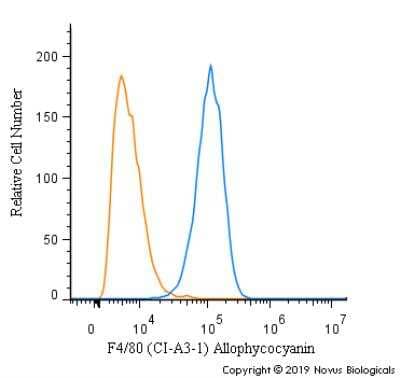F4/80 Antibody (Cl:A3-1)
Novus Biologicals, part of Bio-Techne | Catalog # NB600-404

![Immunohistochemistry: F4/80 Antibody (CI-A3-1) - BSA Free [NB600-404] Immunohistochemistry: F4/80 Antibody (CI-A3-1) - BSA Free [NB600-404]](https://resources.bio-techne.com/images/products/F4-80-Antibody-CI-A3-1-Immunohistochemistry-NB600-404-img0052.jpg)
Conjugate
Catalog #
Key Product Details
Validated by
Biological Validation
Species Reactivity
Validated:
Mouse
Cited:
Human, Mouse, Bacteria - Escherichia coli, Nematode - Caenorhabditis elegans
Applications
Validated:
Flow Cytometry, Immunocytochemistry/ Immunofluorescence, Immunohistochemistry, Immunohistochemistry-Frozen, Immunohistochemistry-Paraffin, Immunoprecipitation, Radioimmunoassay, Western Blot
Cited:
ELISA, Flow Cytometry, IF/IHC, Immunocytochemistry, Immunocytochemistry/ Immunofluorescence, Immunohistochemistry, Immunohistochemistry-Frozen, Immunohistochemistry-Paraffin, Western Blot
Label
Unconjugated
Antibody Source
Monoclonal Rat IgG2B Clone # Cl:A3-1
Concentration
1.0 mg/ml
Product Specifications
Immunogen
Thioglycollate stimulated peritoneal macrophages from C57BL/6 mice
Localization
Cell surface
Marker
Macrophage Marker
Clonality
Monoclonal
Host
Rat
Isotype
IgG2B
Theoretical MW
160 kDa.
Disclaimer note: The observed molecular weight of the protein may vary from the listed predicted molecular weight due to post translational modifications, post translation cleavages, relative charges, and other experimental factors.
Disclaimer note: The observed molecular weight of the protein may vary from the listed predicted molecular weight due to post translational modifications, post translation cleavages, relative charges, and other experimental factors.
Scientific Data Images for F4/80 Antibody (Cl:A3-1)
Immunohistochemistry: F4/80 Antibody (CI-A3-1) - BSA Free [NB600-404]
Immunohistochemistry: F4/80 Antibody (CI-A3-1) [NB600-404] - Oral treatment with L plantarum leads to recruitment of myeloid cells in kidney.Immunostaining of kidney sections from groups of treated mice, in the presence or absence of Leptospira infection using various leukocyte markers. We determined the number of F4/80+ T cells per millimeter squared of kidney. Data are mean SEM of 4-5 mice per group. Scale bar represents 400x. Statistics by two-tailed paired t-test *p < 0.05, *** p < 0.001. Data is representative of one of two experiments. Image collected and cropped by CiteAb from the following publication (doi.org/10.1371/journal.pntd.0005870) licensed under a CC-BY license.Immunocytochemistry/ Immunofluorescence: F4/80 Antibody (CI-A3-1) - BSA Free [NB600-404]
Immunocytochemistry/Immunofluorescence: F4/80 Antibody (CI-A3-1) [NB600-404] - Lymph node stained for macrophages, red and B cells CD79b, green; nuclei are stained with DAPI, blue.Flow Cytometry: F4/80 Antibody (CI-A3-1) - BSA Free [NB600-404]
Flow Cytometry: F4/80 Antibody (CI-A3-1) [NB600-404] - A surface stain was performed on RAW 246.7 cells with F4/80 antibody (CI-A3-1) NB600-404AF488 (blue) and a matched isotype control (orange). Cells were incubated in an antibody dilution of 10 ug/mL for 20 minutes at room temperature. Both antibodies were conjugated to Alexa Fluor 488.Applications for F4/80 Antibody (Cl:A3-1)
Application
Recommended Usage
Flow Cytometry
1:50-1:100
Immunocytochemistry/ Immunofluorescence
1:10-1:500
Immunohistochemistry
1:10-1:500
Immunohistochemistry-Frozen
1:10-1:500
Immunohistochemistry-Paraffin
1:10-1:500
Immunoprecipitation
1:10-1:500RadioImmunoassay 1:100-1:2000
Radioimmunoassay
1:100-1:2000
Western Blot
1:100-1:2000
Application Notes
This product requires pretreatment of paraffin sections prior to staining. Proteinase K is recommended for tissues fixed for less than 24 hours. Citrate buffer pH 6.0 is recommended for tissues fixed for more than 24 hours. E. coli reactivity reported in scientific literature (PMID:31181736).
Reviewed Applications
Read 2 reviews rated 4 using NB600-404 in the following applications:
Formulation, Preparation, and Storage
Purification
Protein G purified
Formulation
PBS
Preservative
0.09% Sodium Azide
Concentration
1.0 mg/ml
Shipping
The product is shipped with polar packs. Upon receipt, store it immediately at the temperature recommended below.
Stability & Storage
Store at 4C short term. Aliquot and store at -20C long term. Avoid freeze-thaw cycles.
Background: F4/80
Depending on factors such as differentiation, activation, and location, the level of F4/80 expression can vary between cell-types (1,2). For example, peritoneal macrophages are subdivided based on morphology and expression with large peritoneal macrophages having high levels of F4/80 and small peritoneal macrophages having low F4/80 expression (1). Furthermore, splenic macrophages are classified based on location (red pulp, marginal zone, and white pulp) and F4/80 expression level varies within these populations as well; the red pulp macrophages have high levels of F4/80 and CD68 by comparison (1). Originally, the F4/80 monoclonal antibody was generated for a macrophage-specific surface antigen, however F4/80 staining is also observed in other hematopoietic cell populations, thus other immune cell markers should be used in conjunction with F4/80 to distinguish between different populations (1). Though the full extent of F4/80 ligands and biological functions remains elusive, studies have suggested that F4/80 is critical for macrophage-natural killer cell interaction and cytokine release (1,2). Additionally, a study of anterior chamber-associated immune deviation (ACAID) indicated a possible role for F4/80 in the generation of regulatory T cells (1,2).
References
1. Dos Anjos Cassado A. (2017). F4/80 as a Major Macrophage Marker: The Case of the Peritoneum and Spleen. Results and Problems in Cell Differentiation. https://doi.org/10.1007/978-3-319-54090-0_7
2. Hamann, J., Hsiao, C. C., Lee, C. S., Ravichandran, K. S., & Lin, H. H. (2016). Adhesion GPCRs as Modulators of Immune Cell Function. Handbook of Experimental Pharmacology. https://doi.org/10.1007/978-3-319-41523-9_15
Additional F4/80 Products
Product Documents for F4/80 Antibody (Cl:A3-1)
Product Specific Notices for F4/80 Antibody (Cl:A3-1)
This product is for research use only and is not approved for use in humans or in clinical diagnosis. Primary Antibodies are guaranteed for 1 year from date of receipt.
Loading...
Loading...
Loading...
Loading...
Loading...
Loading...
![Immunocytochemistry/ Immunofluorescence: F4/80 Antibody (CI-A3-1) - BSA Free [NB600-404] Immunocytochemistry/ Immunofluorescence: F4/80 Antibody (CI-A3-1) - BSA Free [NB600-404]](https://resources.bio-techne.com/images/products/F4-80-Antibody-CI-A3-1-Immunocytochemistry-Immunofluorescence-NB600-404-img0045.jpg)
![Flow Cytometry: F4/80 Antibody (CI-A3-1) - BSA Free [NB600-404] Flow Cytometry: F4/80 Antibody (CI-A3-1) - BSA Free [NB600-404]](https://resources.bio-techne.com/images/products/F4-80-Antibody-CI-A3-1-Flow-Cytometry-NB600-404-img0048.jpg)
![Immunohistochemistry-Paraffin: F4/80 Antibody (CI-A3-1) - BSA Free [NB600-404] Immunohistochemistry-Paraffin: F4/80 Antibody (CI-A3-1) - BSA Free [NB600-404]](https://resources.bio-techne.com/images/products/F4-80-Antibody-CI-A3-1-Immunohistochemistry-Paraffin-NB600-404-img0050.jpg)
![Immunocytochemistry/ Immunofluorescence: F4/80 Antibody (CI-A3-1) - BSA Free [NB600-404] Immunocytochemistry/ Immunofluorescence: F4/80 Antibody (CI-A3-1) - BSA Free [NB600-404]](https://resources.bio-techne.com/images/products/F4-80-Antibody-CI-A3-1-Immunocytochemistry-Immunofluorescence-NB600-404-img0053.jpg)
![Flow Cytometry: F4/80 Antibody (CI-A3-1) - BSA Free [NB600-404] Flow Cytometry: F4/80 Antibody (CI-A3-1) - BSA Free [NB600-404]](https://resources.bio-techne.com/images/products/F4-80-Antibody-CI-A3-1-BSA-Free-Flow-Cytometry-NB600-404-img0054.jpg)
![Immunohistochemistry-Frozen: F4/80 Antibody (CI-A3-1) - BSA Free [NB600-404] Immunohistochemistry-Frozen: F4/80 Antibody (CI-A3-1) - BSA Free [NB600-404]](https://resources.bio-techne.com/images/products/F4-80-Antibody-CI-A3-1-Immunohistochemistry-Frozen-NB600-404-img0046.jpg)
![Immunohistochemistry-Frozen: F4/80 Antibody (CI-A3-1) - BSA Free [NB600-404] Immunohistochemistry-Frozen: F4/80 Antibody (CI-A3-1) - BSA Free [NB600-404]](https://resources.bio-techne.com/images/products/F4-80-Antibody-CI-A3-1-Immunohistochemistry-Frozen-NB600-404-img0047.jpg)
![Flow Cytometry: F4/80 Antibody (CI-A3-1) - BSA Free [NB600-404] Flow Cytometry: F4/80 Antibody (CI-A3-1) - BSA Free [NB600-404]](https://resources.bio-techne.com/images/products/F4-80-Antibody-CI-A3-1-Flow-Cytometry-NB600-404-img0037.jpg)
![Flow Cytometry: F4/80 Antibody (CI-A3-1) - BSA Free [NB600-404] Flow Cytometry: F4/80 Antibody (CI-A3-1) - BSA Free [NB600-404]](https://resources.bio-techne.com/images/products/F4-80-Antibody-CI-A3-1-Flow-Cytometry-NB600-404-img0043.jpg)

![Immunohistochemistry: F4/80 Antibody (Cl:A3-1) [NB600-404] - F4/80 Antibody (Cl:A3-1)](https://resources.bio-techne.com/images/products/nb600-404_rat-monoclonal-f4-80-antibody-ci-a3-1-310202416171463.jpg)